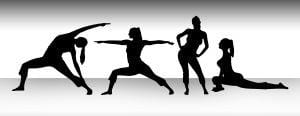Vinyasa yoga, which means “breath-synchronized movement,” is a form of yoga that has become popular among those who practice in Western cultures. In Vinyasa yoga, participants move from one pose to the next in conjunction with a series of controlled and deliberate inhalations and exhalations. Vinyasa yoga emphasizes the entire sequence, rather than a specific pose, so that it becomes one fluid movement.
Purpose
The purpose of Vinyasa yoga is to physically generate heat within the muscles and detoxify the body through a cleansing sweat. Additionally, there are those people who practice what is known as Vinyasa krama, or the steps one takes in order to reach a particular goal. These goals can be short-term, such as clearing the mind through meditation in order to relax; or the goals can be long-term, such as learning a difficult posture. Vinyasa krama can also be applied to a person’s everyday life when faced with a difficult task.
Style
There is no one right way to do Vinyasa yoga, as it is a term that applies to an entire class of yoga and is determined by the instructor’s own philosophy. However, what is important is that rather than focusing on the pose as the main goal, Vinyasa emphasizes the entire process of moving and breathing. In other words, the breaths and fluid movements of each sequence are as equally important as the poses themselves.
Breath
In Vinyasa yoga, the breath, ujjayi pranayama, serves a special purpose. Upward movements are generally performed in correlation with inhalations in order to provide a sense of clarity and lightness. In contrast, exhalations are performed during times of compression, such as bending over or reaching downward. These are performed to ground the participant.
Sequence
A Vinyasa can also be used to describe the series of sequences between poses, particularly in specialized Vinyasa Flow classes. The poses within each Vinyasa are held for longer periods of time to generate muscle heat and to allow the participant ample time for inward reflection. Instead of focusing on the physical form of the pose, she is more attuned to her breathing. One example of a Vinyasa sequence is the “abdomen down.” To perform this sequence, begin at plank position, exhale to chatarunga, inhale to upward facing dog, and exhale to downward-facing dog.
Benefits
Those inexperienced with yoga might dismiss it as an unproductive workout. But those who practice it regularly can attest to better circulation, as well as increased flexibility and muscle tone. In addition, Vinyasa yoga calms the mind and improves outlook. One thing to keep in mind is that Vinyasa yoga can be intense, depending on the teacher’s method of teaching. Therefore, it’s important to visit several different classes before deciding on the style that is right for you.





